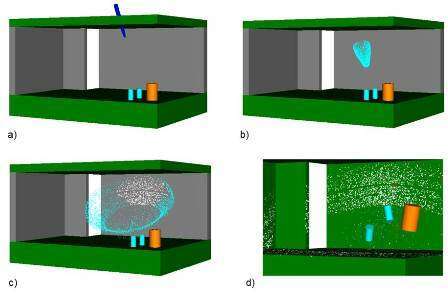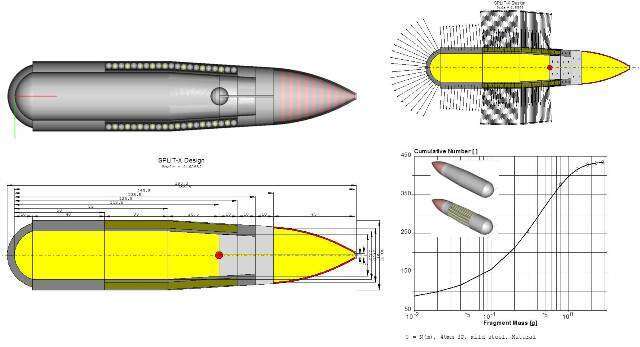The design of protective structures or of warheads defeating such structures is usually an iterative process that requires parametric studies of the warhead and / or the target. In this paper, engineering tools are presented, which can be applied for the analysis of the penetration process of warheads into bunkers or buildings, the subsequent interior detonation and fragmentation and finally the impact of fragments on concrete or masonry walls (see Figure 1).

Figure 1: Military scenario of a warhead attacking a bunker: a) penetration process of the warhead;
b) ignition of the warhead and natural fragmentation; c) trajectory of fragments and blast propagation; d) impact of fragments on walls and containers.
The penetration process is analyzed with PS3D, which simulates the penetration of non-eroding projectiles into solid targets like concrete, sand, soil, aluminium, or steel. A three-dimensional trajectory is obtained for each set of initial conditions, especially the penetration depth or the exit velocity of the projectile. The projectile/target interaction is implemented as a differential area force law (DAFL), which is derived from cavity expansion theories (CET). Besides the included material library, forces laws for other materials can be defined by the user adapting the strength, drag and friction terms. Computational times are in the order of several seconds, so that even large parametric analyses can be done effectively. For user convenience, PS3D can run parametric analyses in batch mode, simulating thousands of impacts within a few hours. Since the elastic and plastic bending deformation of the projectile is also considered in the PS3D analysis, the designer can additionally obtain information about possible warhead failure.
Natural or controlled fragmentation of an explosive filled penetrator can be studied with SPLIT-X (in terms of warhead design and optimization) or with FI-BLAST (in terms of the combined blast and fragment load analysis of structures). In contrast to complex and extremely time-consuming finite element codes, these codes are based on analytical procedures and engineering approximations calibrated and validated by experimental results. Both tools therefore requires relatively little computing time (typically in the range of seconds). The codes calculate all essential parameters such as mass of components and total mass of warhead, number of fragments, ejection angles and velocities, fragment trajectories including retardation in air and gravity, impact points and velocities at the target, target penetration / perforation and fragment density distributions.

Figure 2: SPLIT-X warhead model (left) and exemplary analysis results (right).
All engineering tools, PS3D, SPLIT-X and FI-BLAST have been validated against a variety of experimental results. Besides the theoretical background, a conclusive application example is presented to demonstrate the tools’ capabilities for current research and development.

